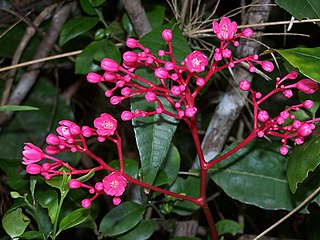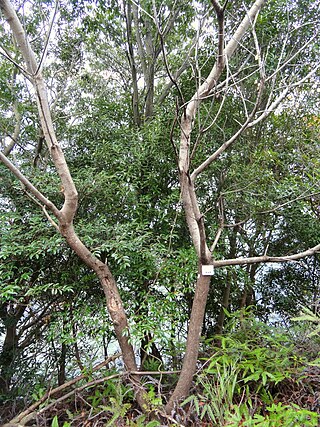
Brucine, is an alkaloid closely related to strychnine, most commonly found in the Strychnos nux-vomica tree. Brucine poisoning is rare, since it is usually ingested with strychnine, and strychnine is more toxic than brucine. In synthetic chemistry, it can be used as a tool for stereospecific chemical syntheses.

Idarubicin or 4-demethoxydaunorubicin is an anthracycline antileukemic drug. It inserts itself into DNA and prevents DNA unwinding by interfering with the enzyme topoisomerase II. It is an analog of daunorubicin, but the absence of a methoxy group increases its fat solubility and cellular uptake. Similar to other anthracyclines, it also induces histone eviction from chromatin.

Brucea is a genus of plant in the family Simaroubaceae. It is named for the Scottish scholar and explorer James Bruce.

Conessine is a steroidal alkaloid found in a number of plant species from the family Apocynaceae, including Holarrhena floribunda, Holarrhena antidysenterica and Funtumia elastica. It acts as a histamine antagonist, selective for the H3 subtype (with an affinity of pKi = 8.27; Ki = ~5 nM). It was also found to have long CNS clearance times, high blood–brain barrier penetration and high affinity for the adrenergic receptors.

Kirkiaceae is a family of flowering plants in the order Sapindales. It comprises one genera, Kirkia, totalling six species. These two genera were previously placed in family Simaroubaceae, but were transferred into their own family because they produce neither quassinoids nor limonoids. Kirkia is named for Captain John Kirk (explorer) of the famous Zambesi Expedition.
Cell-cycle nonspecific antineoplastic agents (CCNS) refer to a class of pharmaceuticals that act as antitumor agents at all or any phases of the cell cycle.

Arsthinol (INN) is an antiprotozoal agent. It was synthesized for the first time in 1949 by Ernst A.H. Friedheim by complexation of acetarsol with 2,3-dimercaptopropanol and has been demonstrated to be effective against amoebiasis and yaws. It was marketed few years later by Endo Products . Among trivalent organoarsenicals, arsthinol was considered as very well tolerated. Recently, it was studied for its anticancer activity.

Romidepsin, sold under the brand name Istodax, is an anticancer agent used in cutaneous T-cell lymphoma (CTCL) and other peripheral T-cell lymphomas (PTCLs). Romidepsin is a natural product obtained from the bacterium Chromobacterium violaceum, and works by blocking enzymes known as histone deacetylases, thus inducing apoptosis. It is sometimes referred to as depsipeptide, after the class of molecules to which it belongs. Romidepsin is branded and owned by Gloucester Pharmaceuticals, a part of Celgene.

Simarouba is a genus of trees and shrubs in the family Simaroubaceae, native to the neotropics. It has been grouped in the subtribe Simaroubina along with the Simaba and Quassia genera. They have compound leaves, with between 1 and 12 pairs of alternate pinnate leaflets. Their flowers are unisexual, relatively small and arranged in large panicles. Plants are dioecious, bearing only male or female flowers. The individual flowers have between 4 and 6 sepals and petals and between 8 and 12 stamens. The fruit is a carpophore and has up to 5 drupaceous mericarps.

Bruceanols are quassinoids isolated from Brucea antidysenterica.

Quassinoids are degraded triterpene lactones of the Simaroubaceae plant family grouped into C-18, C-19, C-20, C-22 and C-25 types. The prototypical member of the group, quassin, was first described in the 19th century from plants of the genus Quassia from which it gets its name. It was isolated in 1937 and its structure elucidated in 1961.

Brucea javanica is a shrub in the family Simaroubaceae. The specific epithet javanica is from the Latin, meaning "of Java". Other common names in English include Java brucea and kosam.

Bruceanol A is a cytotoxic quassinoid isolated from Brucea antidysenterica with potential antitumor and antileukemic properties.

Bruceanol B is a cytotoxic quassinoid isolated from Brucea antidysenterica with potential antitumor and antileukemic properties.

Bruceanol C is a cytotoxic quassinoid isolated from Brucea antidysenterica with potential antitumor and antileukemic properties.

Bruceanol D is a cytotoxic quassinoid isolated from Brucea antidysenterica with potential antitumor and antileukemic properties.

Bruceanol E is a cytotoxic quassinoid isolated from Brucea antidysenterica with potential antitumor and antileukemic properties.

Bruceanol G is a cytotoxic quassinoid isolated from Brucea antidysenterica with potential antitumor and antileukemic properties.

Bruceanol H is a cytotoxic quassinoid isolated from Brucea antidysenterica with potential antitumor and antileukemic properties.

Bruceantin is a chemical compound that was first isolated from the plant Brucea antidysenterica in 1973. Chemically, it is classified as a secotriterpenoid and a quassinoid.



















